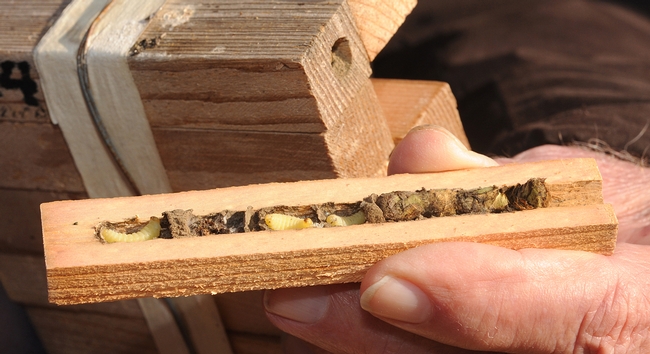When you try to attract leafcutting bees (Megachile spp.) to your bee condos, you may also attract something else.
Wasps.
Bee condos (wood blocks drilled with holes for native bee nests) are a favorite of gardeners and bee enthusiasts. Leafcutting bees lay their eggs in them, provision them with food for the winter, and seal the holes with leaves. Then, in the spring, if all goes well, their offspring will emerge.
Well, some of them will.
Native pollinator specialist Robbin Thorp, emeritus professor of entomology at UC Davis, last year installed some bee condos in the Häagen-Dazs Honey Bee Haven, a half-acre bee friendly garden located next to the Harry H. Laidlaw Jr. Honey Bee Research Facility on Bee Biology Road.
Unlike most bee condos, though, his are removable. That is, you can take them apart and look inside.
Thorp recently did just that. On Dec. 22, he opened one of them and voila! Immature leafcutting bees sharing their bed with immature wasps. The predators and their prey. Strange bedfellows, indeed.
What species of wasp?
"The wasp is one of the solitary mason wasps (family Eumenidae) that uses caterpillars as food for their young," Thorp said. "It may be a species in genus Euodynerus. But I will need to wait until they develop to adults to be sure which genus and species it is."
If you want to attract leafcutting bees, check out Thorp's list of resources for native bee nests.
Just don't expect to rear only native bees.
Attached Images:

Bee condo for leafcutting bees includes the offspring (left) of a solitary mason wasp. (Photo by Kathy Keatley Garvey)

Leafcutting bee (left) emerges from her hole in a photo taken last summer. At right a plugged hole. (Photo by Kathy Keatley Garvey)

Leafcutting bee sealing her nest in a photo taken last summer. (Photo by Kathy Keatley Garvey)